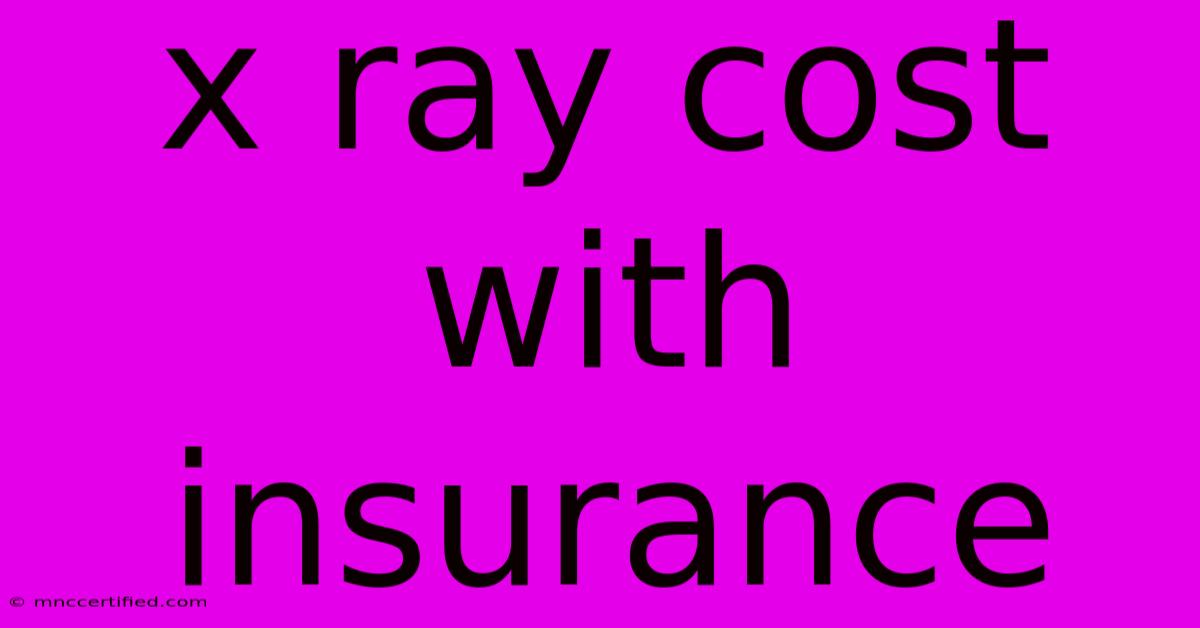X Ray Cost With Insurance

Table of Contents
X-Ray Cost with Insurance: A Comprehensive Guide
Getting an X-ray is a common medical procedure, but understanding the costs involved, especially with insurance, can be confusing. This comprehensive guide breaks down the factors influencing X-ray prices and how your insurance coverage impacts your out-of-pocket expenses. We'll explore various scenarios and offer tips to minimize your costs.
Understanding the Variables Affecting X-Ray Costs
The cost of an X-ray varies significantly depending on several factors:
-
Type of X-Ray: A simple chest X-ray is generally cheaper than a more complex procedure like a dental X-ray or a specialized musculoskeletal X-ray of a specific body part. The complexity of the imaging and the technology used directly impact the price.
-
Facility Type: The location where you get the X-ray plays a crucial role. Costs at a hospital emergency room are typically much higher than at a freestanding imaging center or your doctor's office. Urgent care clinics fall somewhere in between.
-
Geographic Location: Healthcare costs vary considerably depending on your location. Areas with higher costs of living tend to have higher medical expenses, including X-rays.
-
Insurance Plan: Your specific health insurance plan, including your deductible, copay, coinsurance, and whether the facility is in-network, significantly determines your out-of-pocket expense.
Deciphering Your Insurance Coverage
Before getting an X-ray, it's vital to understand your insurance policy. Key terms to know include:
-
Deductible: The amount you must pay out-of-pocket before your insurance coverage kicks in.
-
Copay: A fixed amount you pay for a covered service, such as an X-ray, at the time of service.
-
Coinsurance: Your share of the costs of a covered healthcare service, calculated as a percentage (e.g., 20%) after you've met your deductible.
-
In-Network vs. Out-of-Network: Using in-network providers usually results in lower costs because your insurance company has negotiated discounted rates. Out-of-network providers may charge significantly more, and your insurance may only cover a portion of the bill.
-
Pre-authorization: Some insurance plans require pre-authorization for certain procedures, including X-rays in some cases. Failing to obtain pre-authorization could result in higher out-of-pocket costs or denied claims. Always check with your insurance provider.
Estimating Your Out-of-Pocket Expense
To estimate your X-ray cost, contact your insurance provider before your appointment. They can provide you with:
-
Pre-authorization requirements: Confirm if pre-authorization is needed and complete the necessary steps.
-
Estimated cost: While the exact amount may depend on the specific circumstances, your insurer can provide a reasonable estimate of your copay, coinsurance, and remaining out-of-pocket expenses.
-
In-network provider information: Find out which imaging centers or hospitals are in your network to minimize costs.
Tips for Minimizing X-Ray Costs
-
Check with your doctor: Your physician may be able to refer you to an in-network facility offering lower prices.
-
Shop around: Compare prices from different facilities before scheduling your X-ray, especially if you have a high deductible or coinsurance.
-
Negotiate: In some cases, you may be able to negotiate the price, especially at freestanding imaging centers.
-
Consider payment plans: Some facilities offer payment plans to help manage the cost.
Conclusion: Navigating X-Ray Costs Effectively
The cost of an X-ray with insurance can be unpredictable. However, by understanding your insurance coverage, knowing the factors that influence pricing, and taking proactive steps, you can significantly reduce your out-of-pocket expense and ensure a smoother healthcare experience. Remember to always verify information with your insurance provider and the healthcare facility before your appointment.
Keywords: x-ray cost, x-ray cost with insurance, insurance coverage x-ray, x-ray price, cost of x-ray, medical imaging cost, healthcare costs, deductible, copay, coinsurance, in-network provider, out-of-network provider, pre-authorization, reducing healthcare costs, minimizing medical expenses, affordable healthcare.

Thank you for visiting our website wich cover about X Ray Cost With Insurance. We hope the information provided has been useful to you. Feel free to contact us if you have any questions or need further assistance. See you next time and dont miss to bookmark.
Featured Posts
-
Joe Swash Returns To East Enders After 13 Years
Dec 10, 2024
-
Malibu 100 Acre Brush Fire Update
Dec 10, 2024
-
Roof Shapes For Insurance
Dec 10, 2024
-
Raging Wildfire California Evacuation Order
Dec 10, 2024
-
Montana Llc Car Insurance
Dec 10, 2024